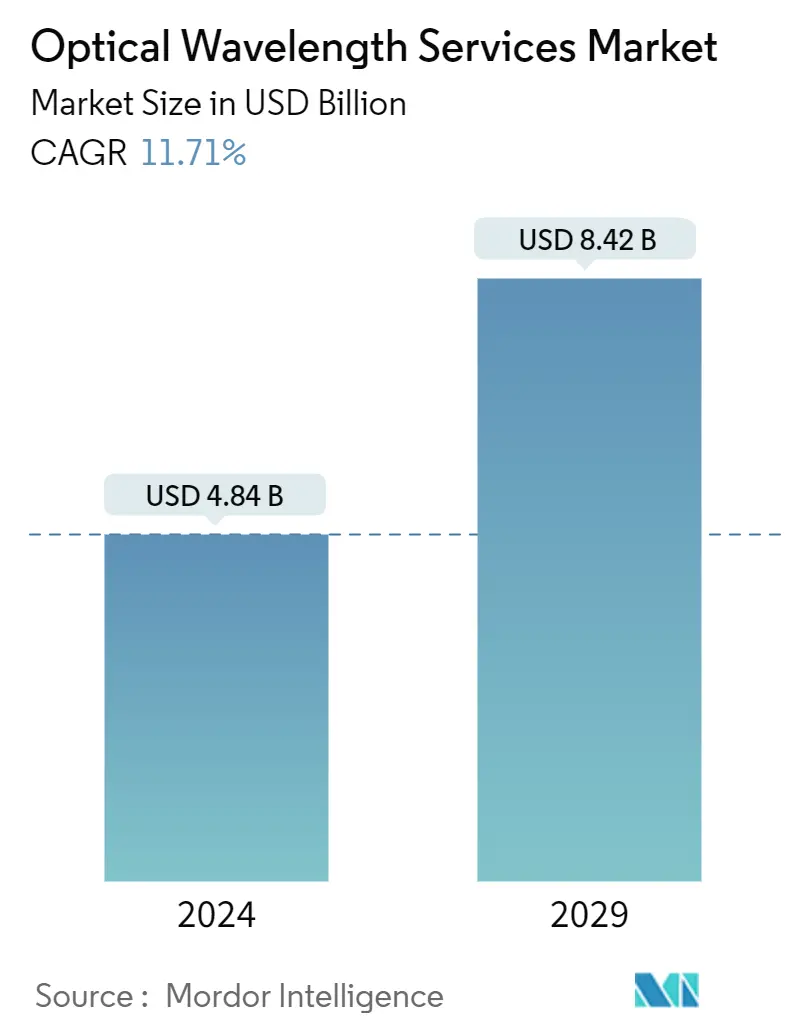Market Size of Optical Wavelength Services Industry

| Study Period | 2019-2029 |
| Market Size (2024) | USD 4.84 Billion |
| Market Size (2029) | USD 8.42 Billion |
| CAGR (2024 - 2029) | 11.71 % |
| Fastest Growing Market | Asia Pacific |
| Largest Market | North America |
| Market Concentration | Medium |
Major Players
*Disclaimer: Major Players sorted in no particular order |
Optical Wavelength Services Market Analysis
The Optical Wavelength Services Market size is estimated at USD 4.84 billion in 2024, and is expected to reach USD 8.42 billion by 2029, growing at a CAGR of 11.71% during the forecast period (2024-2029).
Global data volumes projected to double during forecasted year, there is a growing need to focus on cost and power consumption per bit. Extending large wavelengths across longer distances can make services more cost-effective and efficient for end-users. Larger wavelengths also provide significant network bandwidth expansion, essential to power high-definition content, 5G cell networks, IoT, remote work, and other applications.
- The demand for fiber-to-home (FTTH) systems is increasing, accelerating the deployment of network connections not just in urban areas but also in rural and remote locations. These investments lead to more robust competition among cable companies to create a denser, higher-performance wireless network and high wavelength services.
- In February 2023, Fujitsu launched the Ultra Optical System called 1FINITY, a hyper-reliable optical transport platform delivering extreme performance and scalability with data rates of 1.2 terabits per second (Tbps) on a single wavelength. This platform helps to reduce power consumption and achieve a 60% reduction of CO2 emissions throughout networks.
- Despite the benefits of implementing FTTH more extensively across networks, carriers are still discouraged by the cost of installing additional fiber and the end-users' optical modems. As the industry transitions to larger bandwidths, such as 50G and 100G, which require coherent technology in the modems, this cost issue will worsen.
- Even after the Covid-19 pandemic, network operators continue to add more gear and capacity to support remote work, cloud-based services, streaming video, IoT, and 5G wireless technology. This increasing demand for data and high-speed networks with uninterrupted supply drives Network Solution providers to adopt high wavelengths that can quickly scale up capacity to address traffic bottlenecks or combat slower data transfer speeds.
Optical Wavelength Services Industry Segmentation
Multiple high-bandwidth channels can be transmitted in a single strand of fiber by using dense wavelength division multiplexing (DWDM) technology. High wavelengths are ideal for large multi-site businesses and high-capacity data center transport and carriers. To meet growing bandwidth demands, Wavelength Services expedites the introduction of optical connectivity without incurring significant upfront costs.
The global optical wavelength services market is segmented by bandwidth (less than 10 Gbps, 40 Gbps, 100 Gbps, more than 100 Gbps) and Geography (North America, Asia-Pacific, Europe, and the Rest of the World). The market sizes and forecasts are provided in terms of value (USD).
| By Bandwidth | |
| Less than 10 Gbps | |
| 40 Gbps | |
| 100 Gbps | |
| More Than 100 Gbps |
| Geography | |
| North America | |
| Europe | |
| Asia Pacific | |
| Rest of the World |
Optical Wavelength Services Market Size Summary
The Optical Wavelength Services Market is poised for significant growth, driven by the increasing demand for high-speed data transmission and the expansion of digital infrastructure. As global data volumes continue to rise, there is a pressing need for cost-effective and efficient solutions that can handle the burgeoning demand for bandwidth-intensive applications. Optical wavelength services, which extend large wavelengths over longer distances, offer a scalable and efficient solution, providing substantial network bandwidth expansion essential for powering high-definition content, 5G networks, IoT, and remote work applications. The market is witnessing a surge in demand for fiber-to-home systems, spurring investments in both urban and rural areas, and fostering competition among telecom providers to enhance network performance and connectivity.
The market landscape is characterized by moderate competition, with key players like Zayo Group, Nokia, and Verizon Wireless leading the charge in innovation and strategic partnerships. Technological advancements such as coherent WDM technology and platforms like Fujitsu's Ultra Optical System are enabling higher bit rates and reduced power consumption, making optical transport more cost-effective and environmentally friendly. The Asia-Pacific region, particularly India and China, is emerging as a crucial market due to its high mobile data consumption and rapid adoption of 5G technology. Government initiatives in developing countries are further propelling the growth of communication infrastructure, positioning the optical wavelength services market for robust expansion in the coming years.
Optical Wavelength Services Market Size - Table of Contents
-
1. MARKET DYNAMICS
-
1.1 Market Drivers
-
1.1.1 Growing Demand for the Internet
-
1.1.2 Accelerated Bandwidth-intensive Applications
-
-
1.2 Market Restraints
-
1.2.1 Limited Availability of Incremental Bandwidth
-
1.2.2 Increasing Demand for Virtual Connectivity
-
-
-
2. MARKET SEGMENTATION
-
2.1 By Bandwidth
-
2.1.1 Less than 10 Gbps
-
2.1.2 40 Gbps
-
2.1.3 100 Gbps
-
2.1.4 More Than 100 Gbps
-
-
2.2 Geography
-
2.2.1 North America
-
2.2.2 Europe
-
2.2.3 Asia Pacific
-
2.2.4 Rest of the World
-
-
Optical Wavelength Services Market Size FAQs
How big is the Optical Wavelength Services Market?
The Optical Wavelength Services Market size is expected to reach USD 4.84 billion in 2024 and grow at a CAGR of 11.71% to reach USD 8.42 billion by 2029.
What is the current Optical Wavelength Services Market size?
In 2024, the Optical Wavelength Services Market size is expected to reach USD 4.84 billion.

